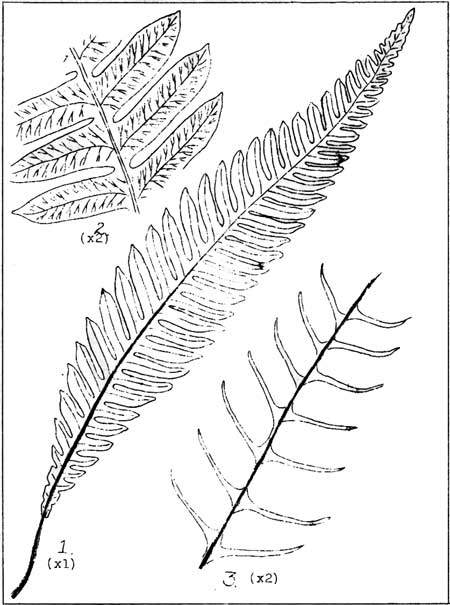 |
|
Deer Fern
(Struthiopteris spicant). 1. Vegetative frond illustrating the
sessile pinnae and general form of the frond (x1). 2. Enlarged sketch
of section of vegetative frond (x2). 3. Portion of reproductive frond
illustrating linear, widely spaced pinnae upon which the spores are
borne (x2). The photographic cover illustrates this species in its
natural habitat.
|
DEER FERN.
(Struthiopteris spicant (L.)
Wies)
The Deer Fern probably ranks next to the Sword Fern as the most
familiar and best known fern of the Park's heavily wooded Canadian zone.
Both are distinctive in appearance, conspicuous and evergreen though
the Deer Fern is not quite as common as the other. It prefers a moist,
shaded habitat in the deep woods and springy well drained soils.
Its botanical range is along the Pacific Coast from Alaska to
California and it is also known in Asia and Europe. Locally it is
found up to 5000 feet. Fronds are of two kinds - vegetative
and spore bearing. Vegetative fronds are evergreen and arranged in a
tufted rosette upon the ground; are from 6"-36" long; one compound, of
leathery texture linear to linear-lanceolate in general outline and
tapering toward both the base and apex. The fronds are widest at the
middle; 3/4"-3" wide. Pinnae are sessile, short, linear in
outline and widest at the base, closely arranged on the stem, glabrous
and with entire and sometimes slightly crenate margins; apex of the
pinnae generally blunt but sometimes acute. Stem of the vegetative
fronds is short - about 1/4 the length of the entire frond.
Spore-bearing fronds are not evergreen, unfolding in the spring and
early summer; are erect; 16-60 inches tall with narrow linear pinnae
spaced far apart on the stem; pinnae sessile with entire margins and
acute apex. Rhizome short and creeping.
-oOo-
SPLEENWORT.
(Asplenium viride
Huds.)
This is rather a rare fern in the park but one that can be readily
identified when found. It is generally foun in crevices on moist
cliffs in the Hudsonian and Arctic-alpine zones. That is the
habitat it prefers. Although a rare plant it is widely
distributed throughout the world - the botanical range
encompassing the region from Alaska across the North American continent
to Greenland and southward to Oregon, Utah, Colorado and South Dakota in
the west and to Vermont in the New England section. It is also widely
distributed in Europe and Asia. Locally its range includes the
Hudsonian and Arctic-alpine zones from about 5000'-7000'.
In generally appearance this fern is short and tufted with fronds
1-1/2"-6" long. Fronds are one compound and linear in outline being
about one-third to one-quarter inch in width. The pinnae are in
pairs, 5-25 such pairs on the stem, are very delicate and bright green
in color, roundish fan-shaped or rhombic in outline with crenulate
(wavy) margins and are attached to the stem by a slender petiole. The
leafstalk is slender, bright green when young but becoming
straw-brown with age. The rhizome is creeping. Sori are
oblong or linear and attached to the upper side of the free vein of the
pinnae. Indusium is present but very delicate.
-oOo-

